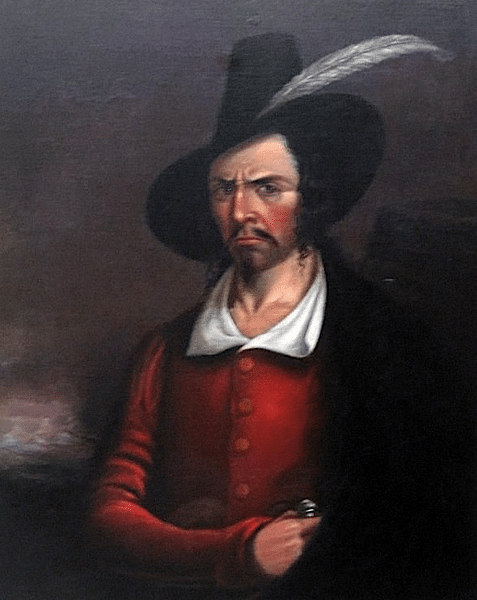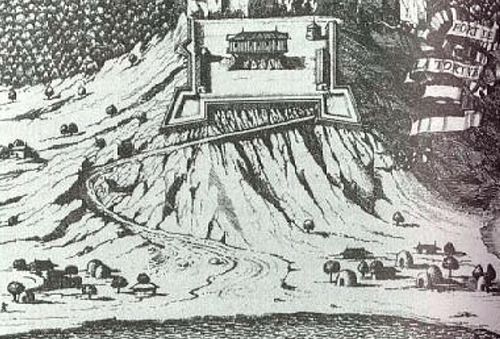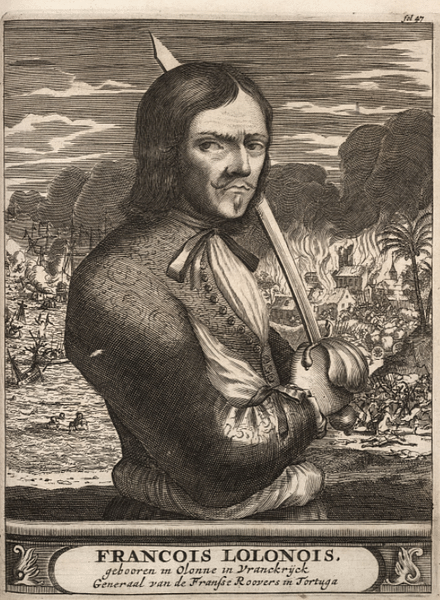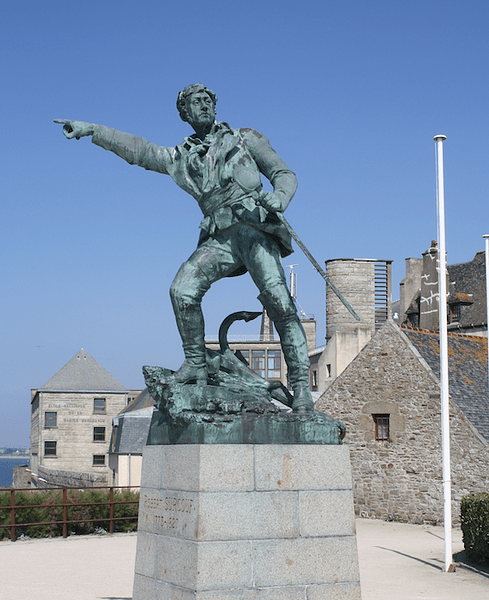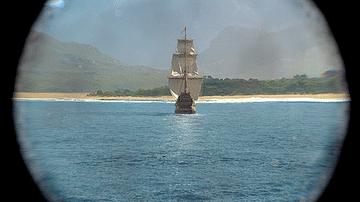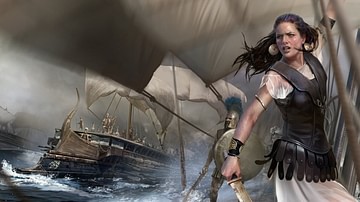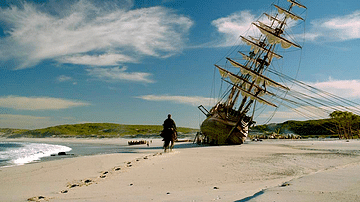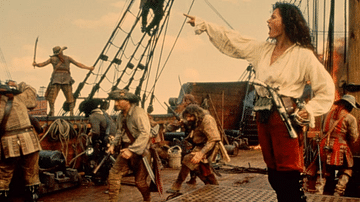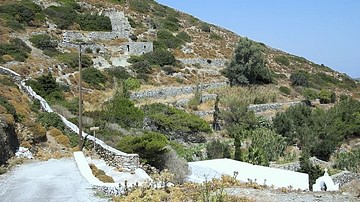Piracy has involved many nationalities over the centuries, but one of the prominent groups in the medieval and early modern periods was the French pirates, who terrorised the Atlantic, the Caribbean, and the Indian Ocean. French writers often preferred to use the term filibuster and corsair for pirates who operated as privateers, and here are presented ten such figures who have made their mark in the annals of crimes at sea.

Eustace the Monk (d. 1217)
Eustace had once been a member of a Benedictine monastery in Boulogne, but he left the simplicity of monastic life to serve the Count of Boulogne. Eustace achieved nothing except disrepute, so much so, he was wanted as a criminal, which led him to run away for a life at sea as a privateer. With his ecclesiastical background and the pirates' love of nicknames, it comes as no surprise that Eustace became known as the 'Black Monk'. At least he found a profession he was good at, and he soon built up a gang of followers who were not too particular about who they privateered for. In the first decade of the 13th century, Eustace was under the employ of King John of England (r. 1199-1216), and so he raided French ships, England and France then being at war. The former monk did sometimes attack English ships, but King John was generous and forgiving; Eustace even had a large residence of his own in London.
Eustace took over the Channel Islands as his base for raids along the French coast and up the River Seine. Eustace was so successful and his skills at navigation so accomplished, rumours abounded that the 'Black Monk' knew magic and could make his ship invisible when required. He lost his haven on the Channel Islands after he switched sides and joined the French. Folkestone was sacked and English shipping attacked in order to keep the English Channel clear for a French invasion of England. Eustace met his end when his own ship was boarded off Sandwich, Kent, his crew having been blinded when the English threw powdered lime in their faces. Eustace was promptly executed without much sympathy.
Jean Fleury (d. 1527)
Jean Fleury (aka Florin) was from Normandy, and he specialised in attacking Spanish treasure fleets and merchant ships when they reached the eastern Atlantic. Working for the Count of Dieppe, Fleury hovered around the Canaries and Azores where he managed to pick up two Spanish ships from the Americas off Cape St. Vincent, Portugal, in June 1523. This was the first time anyone had captured a Spanish treasure ship, and the wealth inside was incredible. There were three chests of gold bullion, 500 pounds of gold dust, 680 pounds of pearls, chests of silver ingots, and several cases of emeralds, including one huge stone the size of the palm of a hand. There was, too, a huge collection of art and religious objects stripped from the Aztec civilization by the Conquistadores, and even a menagerie of exotic wildlife which included jaguars, monkeys, and parrots.
News of Fleury's capture soon spread, and pirates and privateers of all nationalities went in search of similar prizes of their own. Meanwhile, Fleury was captured by a Basque fleet in 1527. The captains refused his bribe of 30,000 ducats to release him and, instead, passed on the most wanted pirate in Europe to Charles V, Holy Roman Emperor (r. 1519-1556). Unsurprisingly, the Spanish king was rather upset at having lost his Aztec treasure and ordered Fleury to be hanged.
Jean Lafitte (c. 1780 to c. 1820)
Jean Lafitte was a smuggler, privateer, and pirate. He went from France to New Orleans at a young age and set up a successful smuggling racket fronted by a blacksmith's business. Moving on to piracy by around 1810, Lafitte was based at the secluded Barataria Bay inlet. He captured ships and sold their cargoes, which often included slaves, to shady merchants in New Orleans. Lafitte's large fleet and multinational band of pirates, privateers, and smugglers caused havoc in the Gulf of Mexico for a decade. Captured once and released on bail, Lafitte did not hang around for trial.
Lafitte then made a complete turnaround and became, instead of a total pest to the New Orleans authorities, their ultimate saviour. In the War of 1812 (June 1812 to February 1815) the United States lined up against Spain, Britain, and its allies. General Andrew Jackson (1767-1845) was charged with defending New Orleans against a British attack, and he wisely took up Lafitte's offer of help. Lafitte's men and 16 cannons from their ships were arranged into artillery units and given the name the Baratarians. The United States duly won the 1815 Battle of New Orleans, and in gratitude, the U.S. President granted Lafitte a pardon. Lafitte could not resist the easy pickings of piracy, though, and he resumed his old life, this time at Galveston, Texas. The U.S. authorities sent ships against him, but in 1821, Lafitte razed Galveston to the ground, sailed over the horizon, and was never heard of again.
François Le Clerc (d. 1563)
François Le Clerc was from Normandy and an all-action pirate who led from the front in privateering attacks. He also put up the cash for other captains to follow suit. His risky approach did not come without its price: Le Clerc injured an arm and lost a leg fighting the English in 1549. At least he gained an aristocratic title in reward for his bravery. The Spanish were another frequent target, and they nicknamed the Frenchman Pié de Palo or 'Peg Leg' (Jambe de Bois in French).
By 1553, Le Clerc was causing havoc in American waters, raiding ports along the Spanish Main and Hispaniola. Sailing back to France, Le Clerc sacked Las Palmas in the Canary Islands. He returned to the Caribbean the next year with an eight-ship fleet and raided Santiago de Cuba in 1554. The attack and subsequent 30 days of looting were so devastating that Santiago never recovered as Cuba's capital, and so it was replaced by Havana. In 1562, Le Clerc turned against his own country and sided with an English invasion force, attacking French ships indiscriminately. Predictably, Le Clerc died in action, this time fighting the Spanish in the Azores in 1563.
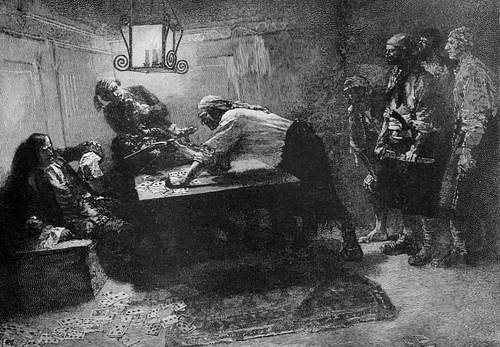
Captain Le Picard (active 1685-88)
Captain Le Picard began his pirate career as a member of the French buccaneers under the command of François Grogniet (d. 1687) who attacked Panama on the Spanish Main in 1685. Eventually commanding his own group of pirates, Le Picard took Granada in 1686. Besides the usual ransom, he asked for the release of five pirate associates then held by the Governor of Panama, but the demand was ignored. In retaliation, Le Picard ordered that 20 captured Spaniards be executed and their heads sent to the governor with a note that if the five pirates were not released, then another 90 captives would be similarly executed. This time the governor did release the men and paid 10,000 silver pesos for Le Picard to release his own Spanish prisoners.
The next year, the French pirate sacked Nicoya (Nicaragua) and Guayaquil (Ecuador). As before, captives were tortured to reveal the location of their hidden valuables, and the Spanish authorities were spurred on to cough up another hefty ransom by the sending of a few heads. The gruesome strategy worked a second time, and Le Picard this time received 42,000 pesos and continued on his merry way. Next targeting settlements in Mexico, Le Picard came a cropper when his fleet was damaged in a storm, and he was obliged to cross the Costa Rican jungle, a dreadful trip that caused the break up of his pirate group.
Jean Le Vasseur (active 1642-52)
Jean Le Vasseur (sometimes known as François) was an odd case since he was an official appointed in 1642 by the French authorities to remove the English and govern Tortuga in northwest Hispaniola (modern Haiti and the Dominican Republic). A Norman nobleman, Huguenot, and gifted military engineer, Le Vasseur went rogue and set up his own mini-state, declaring total independence. With his force of 100 men, he built an impressive fortress, Fort de Rocher, which had more than 40 cannons for its defence. Perched on the cliffs overlooking the harbour, Le Vasseur built his personal palace in the heart of his fortress. The Spanish sent a fleet of six ships to oust the Frenchman, but his castle was well-designed, and his cannons made the port impregnable.
Buccaneers of all nationalities were encouraged to make their base at Tortuga, and for the next decade, Le Vasseur made a fortune from his cut of the plunder that arrived in what became the Caribbean's most important pirate haven. Meanwhile, absolute power seems to have led to absolute madness as Le Vasseur's reign became increasingly troubled. He banned Catholic services, burned down Tortuga's church, and exiled its priest. The Frenchman's reign was noted for its cruel episodes like keeping prisoners in an iron cage called 'Little Hell' since it was so cramped the occupant could not fully stand. Le Vasseur met his comeuppance when he was shot and stabbed by two of his own entourage in 1652.
François L'Olonais (c. 1630-1668)
If one were to compile a list of the most notorious and sadistic pirates of any nationality, François L'Olonais would surely gain entry to the list with ease. Real name Jean-David Nau, L'Olonais was a buccaneer operating from Tortuga. So cruel was he to his captives, he was known as the 'Flail of the Spanish'. Most pirates were satisfied with robbing ships of their cargo, but L'Olonais took no prisoners either at sea or on his raids on the Spanish Main. Those left alive after a battle were executed by beheading, but many first had to undergo various tortures. The buccaneer used the rack on his victims before cutting them up with his cutlass and licking the blood from the blade. The mad pirate even cut off the lips of one captain, while another captive had his heart cut out which L'Olonais proceeded to eat.
In 1667, L'Olonais sacked Maracaibo (Venezuela) over four terrible weeks, ransoming the town for 30,000 silver pieces of eight. In 1668, he attacked the coast of Honduras but found little plunder, and his misfortunes continued when he ran a captured Spanish galleon aground off the coast of Nicaragua. L'Olonais' end was a sticky one. Taken by cannibals off the Mosquito coast, he was cooked and eaten.
Paul de Saumur (1597-1668)
Paul de Saumur (aka Jean-Paul de Saumeur) was a Knight Hospitaller, and so he was known as 'Le Chevalier Paul'. His start in life was a little rocky since he was the illegitimate son of the governor of the famed Chateau D'If in southern France, his mother being a local washerwoman. Taking up a career at sea, things did not improve when he killed an officer in a duel. As for many individuals of fortune, war brought opportunity, and when the captain of the ship he was sailing on was killed, Paul was given the command. Certainly, his fighting and leadership skills were unquestionable; he took on and defeated five Turkish ships singlehandedly in one notable engagement.
Privateering for the French Crown, Paul was based on Lesbos while he ravaged shipping in the Aegean. The Knights Hospitaller on Malta, partial to a bit of piracy when the opportunity arose, saw Paul's potential, and he was invited to join the order in 1637. He became commander of a galley, and his success then attracted the French navy, who appointed him captain of a ship of the line in 1638. In 1647, he famously led a raid against Naples and beat off a fleet five times the size of his own. In 1649 he was made a knight, and in 1652 he was appointed lieutenant-general of the Near East. He died of gout in 1668.

Jacques de Sores (active 1553-70)
Jacques de Sores was a privateer from Normandy, and his claim to infamy was a brutal attack on Havana in July 1555. Hoping to find a treasure store in the town, de Sores was sorely disappointed. The governor, who had fled at the sight of the corsairs' approach, launched a counterattack which was rebuffed. De Sores then executed 24 prisoners. A ransom of 1,000 pesos was offered, but this was a very small figure. De Sores responded to what he considered an insult by setting the town ablaze, including churches. His men burnt the surrounding fields and hanged the African slaves who worked them. They then sank all the boats in the harbour and left with next to nothing to show for their brutality.
Jaques de Sores returned to Europe, and in 1569, he was appointed commander of a French naval fleet. The ex-pirate showed no sign of mellowing, and, capturing Venetian merchant ships, he continued to shoot prisoners without mercy. His last and most notorious deed was when he captured a Portuguese vessel in the Canaries in July 1570. The ship was carrying 40 Jesuit missionaries, and these were cast overboard along with their books and icons. The other passengers fared no better, and only six from 500 survived the merciless attack.
Robert Surcouf (active 1794-1810)
Robert Surcouf hailed from Saint-Malo in Brittany, and he became the most infamous of the French privateers who stalked merchant ships in the Indian Ocean during the French Revolutionary Wars (1792-1802). Like many mariners, Surcouf had run away to sea when only a teenager, but he rose to captain a small slave ship that took Africans from East Africa to Mauritius, then a French colony. In 1795, the French government banned the slave trade and so Surcouf became a privateer. Surcouf added some cannons to his brig the Émilie, and off he sailed to find merchant ships carrying riches from Asia around the Cape of Good Hope and on to Europe.
A significant capture in 1796 was the British Triton in the Bay of Bengal, which was loaded with precious spices. Surcouf's problem, though, was not the British but the governor of Mauritius who refused to issue him a Letter of Marque that gave him the official right to privateer. As a consequence, his captures were confiscated. Surcouf solved the problem by sailing to France and acquiring a Letter of Marque there. He returned to Mauritius and was duly given his prizes. Surcouf now had two small ships, the Confiance and Clarisse, and with these, he made another notable capture in 1800, again a British merchant vessel sailing from India, the Kent. When peace was agreed between England and France in 1802, Surcouf returned to France, but he was soon back to privateering, this time using his home town Saint-Malo as a base before moving on to raid the Caribbean with success in 1807. The French emperor Napoleon Bonaparte (r. 1804-1814 & 1815) certainly valued Surcouf, awarding the privateer a barony according to legend, and so did the French navy, naming several important ships and one submarine after him, further cementing his place as one of the most famous of all French sea-raiders.

